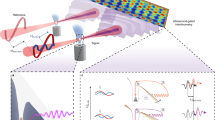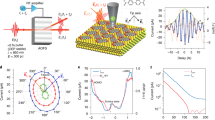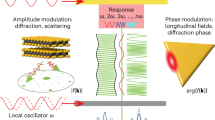Abstract
Interferometry is a basic tool to resolve coherent properties in a wide range of light or matter wave phenomena. In the strong-field regime, interferometry serves as a fundamental building block in revealing ultrafast electron dynamics. In this work we manipulate strong-field-driven electron trajectories and probe the coherence of a molecular wavefunction by inducing an interferometer on a microscopic level. The two arms of the interferometer are controlled by a two-colour field, while the interference pattern is read via advanced, three-dimensional high-harmonic spectroscopy. This scheme recovers the spectral phase information associated with the structure of molecular orbitals, as well as the spatial properties of the interaction itself. Zooming into one of the most fundamental strong-field phenomena—field-induced tunnel ionization—we reconstruct the angle at which the electronic wavefunction tunnels through the barrier and follow its evolution with attosecond precision.
This is a preview of subscription content, access via your institution
Access options
Access Nature and 54 other Nature Portfolio journals
Get Nature+, our best-value online-access subscription
$29.99 / 30 days
cancel any time
Subscribe to this journal
Receive 12 print issues and online access
$209.00 per year
only $17.42 per issue
Buy this article
- Purchase on Springer Link
- Instant access to full article PDF
Prices may be subject to local taxes which are calculated during checkout




Similar content being viewed by others
Data availability
The data that support the plots within this paper and other findings of this study are available from the corresponding author upon reasonable request.
References
Ott, C. et al. Reconstruction and control of a time-dependent two-electron wave packet. Nature 516, 374–378 (2014).
Smirnova, O. et al. High harmonic interferometry of multi-electron dynamics in molecules. Nature 460, 972–977 (2009).
Sansone, G. et al. Electron localization following attosecond molecular photoionization. Nature 465, 763–766 (2010).
Calegari, F. et al. Ultrafast electron dynamics in phenylalanine initiated by attosecond pulses. Science 346, 336–339 (2014).
Ghimire, S. et al. Observation of high-order harmonic generation in a bulk crystal. Nat. Phys. 7, 138–141 (2011).
Vampa, G. et al. Linking high harmonics from gases and solids. Nature 522, 462–464 (2015).
Le, A.-T., Morishita, T. & Lin, C. Extraction of the species-dependent dipole amplitude and phase from high-order harmonic spectra in rare-gas atoms. Phys. Rev. A 78, 023814 (2008).
Lewenstein, M., Balcou, P., Ivanov, M. Y., L’huillier, A. & Corkum, P. B. Theory of high-harmonic generation by low-frequency laser fields. Phys. Rev. A 49, 2117–2132 (1994).
Corkum, P. B. Plasma perspective on strong field multiphoton ionization. Phys. Rev. Lett. 71, 1994–1997 (1993).
Smirnova, O. & Ivanov, M. in Attosecond and XUV Physics: Ultrafast Dynamics and Spectroscopy (eds Schultz, T. & Vrakking, M.) Ch. 7 (Wiley, 2014).
Haessler, S. et al. Attosecond imaging of molecular electronic wavepackets. Nat. Phys. 6, 200–206 (2010).
Vozzi, C. et al. Generalized molecular orbital tomography. Nat. Phys. 7, 823–827 (2011).
Mairesse, Y. & Quéré, F. Frequency-resolved optical gating for complete reconstruction of attosecond bursts. Phys. Rev. A 71, 011401 (2005).
Mairesse, Y. et al. Attosecond synchronization of high-harmonic soft X-rays. Science 302, 1540–1543 (2003).
Sansone, G. et al. Isolated single-cycle attosecond pulses. Science 314, 443–446 (2006).
Azoury, D. et al. Electronic wavefunctions probed by all-optical attosecond interferometry. Nat. Photon. 13, 54–59 (2019).
Mairesse, Y. et al. High-order harmonic transient grating spectroscopy in a molecular jet. Phys. Rev. Lett. 100, 143903 (2008).
Rupenyan, A., Bertrand, J. B., Villeneuve, D. M. & Wörner, H. J. All-optical measurement of high-harmonic amplitudes and phases in aligned molecules. Phys. Rev. Lett. 108, 033903 (2012).
Levesque, J. et al. Polarization state of high-order harmonic emission from aligned molecules. Phys. Rev. Lett. 99, 243001 (2007).
Mairesse, Y. et al. High harmonic spectroscopy of multichannel dynamics in strong-field ionization. Phys. Rev. Lett. 104, 213601 (2010).
Shafir, D. et al. Resolving the time when an electron exits a tunnelling barrier. Nature 485, 343–346 (2012).
Shafir, D., Mairesse, Y., Villeneuve, D., Corkum, P. & Dudovich, N. Atomic wavefunctions probed through strong-field light–matter interaction. Nat. Phys. 5, 412–416 (2009).
Dudovich, N. et al. Measuring and controlling the birth of attosecond XUV pulses. Nat. Phys. 2, 781–786 (2006).
Pedatzur, O. et al. Attosecond tunnelling interferometry. Nat. Phys. 11, 815–819 (2015).
Niikura, H., Dudovich, N., Villeneuve, D. & Corkum, P. Mapping molecular orbital symmetry on high-order harmonic generation spectrum using two-color laser fields. Phys. Rev. Lett. 105, 053003 (2010).
Boutu, W. et al. Coherent control of attosecond emission from aligned molecules. Nat. Phys. 4, 545–549 (2008).
Bruner, B. D. et al. Multidimensional high harmonic spectroscopy of polyatomic molecules: detecting sub-cycle laser-driven hole dynamics upon ionization in strong mid-IR laser fields. Faraday Discuss. 194, 369–405 (2016).
Pfeiffer, A. N. et al. Attoclock reveals natural coordinates of the laser-induced tunnelling current flow in atoms. Nat. Phys. 8, 76–80 (2012).
Harvey, A. G., Brambila, D. S., Morales, F. & Smirnova, O. An R-matrix approach to electron–photon–molecule collisions: photoelectron angular distributions from aligned molecules. J. Phys. B 47, 215005 (2014).
Mašín, Z. et al. Electron correlations and pre-collision in the re-collision picture of high harmonic generation. J. Phys. B 51, 134006 (2018).
Pavičić, D., Lee, K. F., Rayner, D. M., Corkum, P. B. & Villeneuve, D. M. Direct measurement of the angular dependence of ionization for N2, O2, and CO2 in intense laser fields. Phys. Rev. Lett. 98, 243001 (2007).
Majety, V. P. & Scrinzi, A. Dynamic exchange in the strong field ionization of molecules. Phys. Rev. Lett. 115, 103002 (2015).
Murray, R., Spanner, M., Patchkovskii, S. & Ivanov, M. Y. Tunnel ionization of molecules and orbital imaging. Phys. Rev. Lett. 106, 173001 (2011).
Eckart, S. et al. Ultrafast preparation and detection of ring currents in single atoms. Nat. Phys. 14, 701–704 (2018).
Torlina, L. et al. Interpreting attoclock measurements of tunnelling times. Nat. Phys. 11, 503–508 (2015).
Kaushal, J., Morales, F. & Smirnova, O. Opportunities for detecting ring currents using an attoclock setup. Phys. Rev. A 92, 063405 (2015).
Hartung, A. et al. Electron spin polarization in strong-field ionization of xenon atoms. Nat. Photon. 10, 526–528 (2016).
Barth, I. & Smirnova, O. Spin-polarized electrons produced by strong-field ionization. Phys. Rev. A 88, 013401 (2013).
Wörner, H. J. et al. Conical intersection dynamics in NO2 probed by homodyne high-harmonic spectroscopy. Science 334, 208–212 (2011).
Acknowledgements
We thank G. Orenstein and M. Kruger for helpful discussions and Z. Masin for his theoretical support. N.D. is the incumbent of the Robin Chemers Neustein Professorial Chair. N.D. acknowledges the Minerva Foundation, the Israeli Science Foundation, the Crown Center of Photonics and the European Research Council for financial support. O.S. and M.I. acknowledge support of the DFG QUTIF grants. M.I. acknowledges support of EPSRC/DSTL MURI grant no. EP/N018680/1.
Author information
Authors and Affiliations
Contributions
N.D., O.S., M.I. and B.P. supervised the study. A.J.U., H.S. and B.D.B. designed and built the experimental set-up. A.J.U., H.S. and O.P. carried out the measurements and analysed the data. M.I. and O.S. conceived and performed the theoretical calculations. A.C., S.L. and B.P. developed and studied the theoretical analysis of the Coulomb effects. A.J.U., H.S. and N.D. interpreted the experimental and theoretical results. All authors discussed the results and contributed to the final manuscript.
Corresponding author
Ethics declarations
Competing interests
The authors declare no competing interests.
Additional information
Publisher’s note Springer Nature remains neutral with regard to jurisdictional claims in published maps and institutional affiliations.
Supplementary information
Supplementary Information
Supplementary Figs. 1–14, detailed description of the theory, numeric calculations and discussion.
Rights and permissions
About this article
Cite this article
Uzan, A.J., Soifer, H., Pedatzur, O. et al. Spatial molecular interferometry via multidimensional high-harmonic spectroscopy. Nat. Photonics 14, 188–194 (2020). https://doi.org/10.1038/s41566-019-0584-2
Received:
Accepted:
Published:
Issue Date:
DOI: https://doi.org/10.1038/s41566-019-0584-2
This article is cited by
-
High-harmonic spectroscopy of low-energy electron-scattering dynamics in liquids
Nature Physics (2023)
-
Real-time multispeckle spectral-temporal measurement unveils the complexity of spatiotemporal solitons
Nature Communications (2021)
-
Looking into strong-field dynamics
Nature Photonics (2020)



